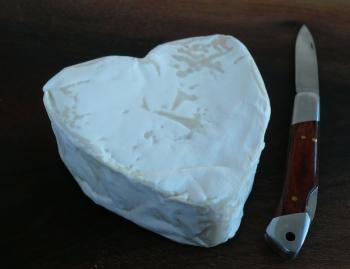Coeur de Neufchâtel
- Producer
- Various
- Country
- France
- Region
- Haute Normandie
- Size
- 4 ins diameter, 1 in high
- Weight
- 8oz
- Website
- Milk
- Cow
- Classification
- Semi Soft
- Rennet
- Animal
- Rind
- Mold Ripened

Neufchâtel is produced in Haute Normandie, in the area around the village of Neufchâtel-en-Bray. Made from cow's milk, its one of France's oldest established cheeses with production reputedly dating back as far as 1035. One of the reasons for the cheese's consistent popularity is that the town of Neufchâtel-en-Bray is located only 82 miles from the markets of Paris. It was also mentioned in early guides and almanacs for gourmands. Neufchâtel comes in six different shapes and sizes; "bonde and double bonde" - large and small cylinders, "carre" - a square, "briquette" a small ingot or brick shape and "coeur" and "grand coeur" small and large hearts. The heart shape is said to have originated during the Hundred Years War (14th & 15th centuries) when English soldiers were stationed in Normandie. The French farm girls, all of whom made cheese, fell in love with them and started making heart-shaped cheeses. The recipe for production of the cheese, regardless of shape, was granted AOC status in 1969 and is consequently protected. Production can be industrial, farmstead or artisanal. Milk for production comes exclusively from the Normandie breed of cow, an animal whose milk is particularly well-suited to cheesemaking. This reflects a 2007 change to the AOC rules and some dairies are still in transition, still using milk from other breeds such as Montbeliard. For artisanal production, fresh, warm milk is transferred straight from the milking parlor to the cheesemaking room. The milk is heated and rennet added two hours later. After the curds are formed and cut, they are transferred to cotton bags and allowed to drain under their own weight for several hours. The bags are then placed in a press in order to extract as much whey as possible - it is this process that differentiates Neufchâtel from other Normandy cheeses. The result of this pressing is that the paste of the cheese is more grainy and thicker instead of the wet, tender curds that associated with, for instance, the production of Camembert. Traditionally, after the curds are removed from the bags, the cheeses are salted by hand. However, many cheesemakers are now adding the salt to the curd in order to achieve a more consistent and less salty end result. A light sprinkling of Penicilium Candidum is also added to the mix, in order to give the cheeses a jump start with the development of the white bloomy mold that grows on the exterior. Once shaped, the cheeses are transferred to a temperature-controlled cave and on the fourth day, turned (flipped) in order to maintain an even distribution of moisture and mold development. Maturation takes a minimum of ten days before the cheeses are released although many cheeses are aged for longer with the result that the interior becomes less chalky in consistency. The exterior rind is white and velvety. Flavors are mushroomy, rich and slightly yeasty, depending on age.



